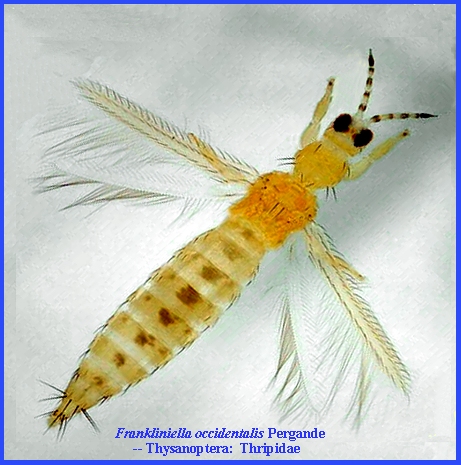File: <westernflowerthrips > Pooled References GENERAL
INDEX [Navigate to MAIN MENU ]
|
Western Flower Thrips Frankliniella occidentalis Pergande --
Thysanoptera: Thripidae |
------ CLICK on photo to enlarge. To search for Subject Matter, Depress Ctrl/F
----------------------------------------------------------------------------------------------------------------------------------
|
Once the plant is infected it cannot
be saved and different symptoms may be expressed depending on the strain of
the virus. Symptoms include stunting,
distortion, mottling, general necrosis, and ring spots. Virulent forms of the virus can kill
plants resulting in major economic losses.
When feeding thrips larvae acquire the virus they are permanently
infected (the virus replicates in the thrips and persists as they mature. An infected adult that encounters a susceptible
plant and starts feeding can transmit the pathogen quickly. Large numbers of these pests that migrate
from other crops and weeds cause high levels of virus transmission and
disease outbreaks. The virus also
mutates and can develop strains that overcome resistant host crop varieties. REFERENCES:
FURTHER RELATED REFERENCES Ansari,
M. A., et al. 2007. Control of western flower thrips (Frankliniella occidentalis) pupae with Metarhizium anisopliae in peat and peat
alternative growing media. Biological
Control 40 (3): 293-297. Chen,
Tian-Ye; Chang-Chi Chu, Glenn Fitzgerald,
Eric T. Natwick & Thomas J. Henneberry. 2004. Trap Evaluations for Thrips
(Thysanoptera: Thripidae) and Hoverflies (Diptera: Syrphidae). Environmental Entomology. Entomological Society of America 33 (5):
1416–1420. Complexity and Local
Specificity of the Virome Associated with Tospovirus-Transmitting Thrips
Species.
Journal of Virology 95: 21. Childers,
C. C, R. J.. Beshear, G. Frantz
& M. Nelms. 2005. A review of thrips species biting man
including records in Florida and Georgia between 1986-1997. Florida Entomologist: Vol.
88 (4): 447–451. Clarke,
G. M., S. Gross, M. Matthews, P. C. Catling,
B. Baker, C. L. Hewitt, D. Crowther & S. R. Saddler. 2000.
Environmental Pest Species in Australia, Australia: State of the
Environment. Second Technical Paper
Series (Biodiversity), Department of
the Environment and Heritage, Canberra, Australia. Orius laevigatus (Insecta;
Heteroptera) local strain, a promising agent in biological control of Frankliniella occidentalis (Insecta;
Thysanoptra) in protected pepper crops in Tunisia. Euro-Mediterranean Journal for
Environmental Integration 3: 1. Kirk,
D. J. & I. L. Terry. 2003. The spread of the western flower thrips Frankliniella occidentalis
(Pergande). Agricultural and Forest
Entomology 5: 301-310. Semiochemicals for
Thrips and Their Use in Pest Management. Annual Review of Entomology. 66 (1): 101-119. Elevated CO2 mediated plant VOCs change aggravates
invasive thrips occurrence by altering their host selection behaviour. Journal of
Applied Entomology 145 (8): 777-788. Ogada,
P. A.; E. Maiss &
H. M. Poehling. 2012. Influence of tomato spotted wilt virus on
performance and behaviour of western flower thrips (Frankliniella occidentalis). Journal of Applied Entomology 137
(7): 488–498. Edaphic mesostigmatid
mites (Acari: Mesostigmata) and thrips (Insecta: Thysanoptera) in rose
cultivation and secondary vegetation areas in the Bogotá plateau, Colombia. International
Journal of Acarology. 47 (1): 8-22. Shipp,
J. L. & K. Wang. 2006.
Evaluation of Dicyphus hersperus
(Heteroptera: Miridae) for biological control of Frankliniella occidentalis
(Thysanoptera: Thripidae) on greenhouse tomato. Journal of Economic Entomology. 99 (2): 414–420. Stafford,
C. A.; G. P. Walker & D. E. Ullman.
2011. Infection with a plant
virus modifies vector feeding behavior.
Proceedings of the National Academy of Sciences of the United States
of America. 108 (23): 9350–9355. Worldwide border interceptions provide a window into
human‐mediated global insect movement. Ecological Applications 31: 7.
Mutation
(G275E) of nAChR subunit
Foα6 associated with spinetoram resistance in Australian western flower
thrips, Frankliniella occidentalis
(Pergande).
Molecular Biology Reports 48 (4): 3155-3163. Different population
performances of Frankliniella occidentalis
and Thrips hawaiiensis on
flowers of two horticultural plants. Journal of Pest Science 1: 79-91. Triapitzin, S. V. & D. H. Headrick. 1995. A review of the Nearctic
species of the thrips-attacking genus Ceranisus
Walker (Hymenoptera: Eulophidae).
Transactions of the American Entomological Society 121 (4): 227-248. Triapitzin, S.
V. & J. G. Morse. 1999. Survey of parasitoids of citrus thrips, Scirtothrips citri (Moulton), in
southern California. Russian Entomological
Journal 8 (1). |
